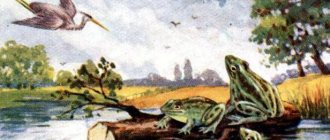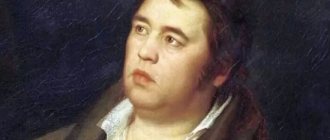Fable The Wolf and the Crane read text
Everyone knows that wolves are greedy: a wolf, having eaten, never takes apart the bones. But trouble came to one of them! He almost choked on a bone. The Wolf can neither sigh nor sigh; It's time to stretch your legs! Luckily, the Crane happened close here. So the Wolf began to beckon him with some signs and asked for help for grief.
The Crane stuck its nose up to the neck into the Wolf's mouth and with great difficulty pulled out the bone and began to ask for the labor. "Are you kidding! - the insidious beast cried, - For your work? Oh, you ungrateful one! And it’s nothing that you took your long nose and your stupid head out of your throat intact! Come on, buddy, get away, but be careful: don’t get caught by me ahead.”
Brief summary of the fable The Wolf and the Crane by Krylov for the reader's diary
Wolves are very greedy, and also cunning, everyone knows this.
When they eat, they are in a hurry, they don’t even see the bones. One of the gray predators got into trouble. He greedily grabbed the food and choked on a bone. The bone has become across the throat, and the poor wolf can neither inhale nor exhale. I’m completely exhausted, how to live now? He cannot remove the bone himself. The wolf was about to stretch out his legs, but luckily for him, a crane was nearby.
The predator saw the crane and called with signs for help. The crane came up, understood the situation, and stuck its long beak into the wolf's throat. With great effort he pulled out the ill-fated bone. The wolf was freed from his trouble.
As soon as the bird has provided assistance, immediately start asking for payment for your hard work. To which the wolf told him to get out of the way to the best of his ability. He advised the crane to be glad that he did not swallow it. The wolf no longer wanted to deal with the crane.
Many fables, folk tales, and indeed any works contain some kind of meaning. This fable teaches us mutual assistance. If you have already decided to help someone, do it free of charge, without asking for payment for your work. The crane did not act nicely, but the wolf could have simply said thank you, and not threatened his savior. Both animals behaved inappropriately; each sought their own benefit from this problem. You can't do that.
Analysis of the fable The Wolf and the Crane
I.A. Krylov is a famous Russian fabulist, who was not for nothing called “an expert on human souls.” He, like no one else, noticed all the vices of his contemporary society and allegorically described human character through images of animals. His ability to give a fictional image the features of real people, and through comical situations to show the moral of the fable, is relevant to this day. Human vices do not change over time and in many of I.A.’s heroes. Krylov can be easily recognized by acquaintances even many centuries after the creation of the fable.
The main character is a wolf, who from the first lines is described as a negative hero. In the fabulist's case, he is greedy, swallows everything indiscriminately and does not look at what came from where. Of course, such unbridled greed led to the wolf choking. This is where the second hero of the fable appears - the crane.
The wolf is helpless and cannot cope without the help of his enemy. The crane strives to help, even those who have always been dangerous to him. However, after help, he asks for gratitude, and in response he receives only threats and curses.
The crane is kind and compassionate, but help should be provided without expecting anything in return, especially from greedy and evil people. The moral is that by helping an unworthy person you will get nothing but curses and discontent. Greedy and evil people should remember that without thanking for help one time after another, they may not receive it.
The wolf chokes on a bone and asks the crane for help. He helps, but instead of gratitude he receives curses.
Other retellings and reviews for the reader's diary
Vitaly Bianchi's fairy tale “The Sly Fox and the Smart Duck” tells the story of how one day in the fall the Sly Fox wanted to eat a duckling. He went to the lake, crept up from behind the bushes and saw a large flock of ducks.
The author's family went to the dacha. Their plans are ruined, and they are also accused of something they didn’t do. Being offended, they go through many tests. They meet the guys, the watchman's grandfather, and see the famous Polkan.
At the beginning of the story, the hero looks at a small picture in a simple frame and remembers his youth. Then the story moves to the years of the Great Patriotic War.
The story is told from the author's point of view. Through his eyes one can observe grandmother Olena Danilovna and her grandson, Vladimir, whom the author calls Vovka. The boy's father was on a business trip, his mother was in the hospital
Source
Read the text of the fable:
Everyone knows that wolves are greedy: a wolf, having eaten, never takes apart the bones.
But trouble came to one of them! He almost choked on a bone. The Wolf can neither sigh nor sigh; It's time to stretch your legs! Luckily, the Crane happened close here. So the Wolf began to beckon him with some signs and asked for help for grief. The Crane stuck its nose up to the neck into the Wolf's mouth and with great difficulty pulled out the bone and began to ask for the labor. \"Are you kidding! - the insidious beast cried, - For your work? Oh, you ungrateful one! And it’s nothing that you took your long nose and your stupid head out of your throat intact! Come on, buddy, get away, but be careful: don’t get caught by me ahead."
Krylov's fable “The Wolf and the Crane”: how to write a summary?
Krylov's fable. Wolf and crane. Summary.
Brief summary of the fable “The Wolf and the Crane” by Krylov.
The fable “The Wolf and the Crane” by Krylov, like many of his other fables, is quite short. But at the same time very instructive. Its summary can be presented as follows:
The fable shows how ungrateful and arrogant a person can be. While he feels bad, he is ready to ask for help from anyone, even his “enemies.” But as soon as the danger passes, you won’t even get a word “thank you” from such a person. He immediately forgets all kindness and help. A very real life situation is described in this fable.
The fable “The Wolf and the Crane” is a vivid representation of human ingratitude, expressed in literary language, and expressed by the example of animal behavior.
The wolf, choking on a bone, called upon the power of the Crane to remove the bone stuck in his throat. The crane conscientiously did his job and saved the wolf from pain.
And among people there are people who forget kindness, do not remember help, and do not reciprocate.
It’s quite easy to retell in prose the content of this fable by Ivan Krylov. You can do it like this:
Once upon a time there was a Wolf who loved meat, like all his brothers. The Wolf had already eaten a lot of meat along with bones, but one day the bone got stuck in his throat. The wolf could not breathe, he felt very bad. And then he turned to the Crane so that he would pull the bone out of his throat with his long beak.
The crane did not refuse help; with great difficulty he removed the bone from the predator’s throat. The wolf began to breathe freely. And the Crane asked for payment for his “surgical” work.
And then the Wolf became furious and said that as a sign of gratitude he did not eat the Crane, although he could have done so. And the Wolf drives away his savior.
And if you decide to help someone, then do it from the heart and do not then demand payment for your help. The fable also teaches this.
I.A. Krylov is a famous fabulist who, using the example of animals, very clearly showed human vices.
One of these fables is the fable called “The Wolf and the Crane.”
In the fable, we meet the main character, a wolf who is greedy and evil. The wolf is famous for its greed and when eating it does not know where the meat is and where the bones are.
This time, too, he ate so carelessly that he choked on a bone, and so much so that it was a matter of “life or death.”
The wolf has no choice but to turn for help to a crane passing nearby. The wolf asks to remove the bone from his throat.
The crane decides to help the wolf and sticks his “nose up to his neck” and removes the bone from the wolf’s throat. In its simplicity, the crane asks for gratitude from the wolf for its salvation, but how can one expect good from an evil and greedy wolf?
The wolf drives the crane away with the words:
The moral of this story is:
You shouldn’t expect gratitude from greedy people, and doing good you shouldn’t demand gratitude. Help and revenue must come from a “pure heart.”
At the beginning of the fable, a hungry wolf, greedily swallowing food, does not care at all about separating the bones from it, swallowing them in a hurry. However, this backfires on him, since one of the bones gets stuck in his throat and from it, the wolf begins to choke.
Next to the wolf, there is a crane, who understands that the wolf is asking him for help, as he is suffocating. As a result, the crane, showing mercy, uses its long beak to pull the bone out of the wolf’s throat.
After this, the crane waits for a reward, but an aggressive wolf drives him away. Moreover, in the form of arguments in his favor, he says that the crane should thank him for the fact that he remained alive at all.
The fable “The Wolf and the Crane” is short in length, but a lot of interesting things happen in it.
So the wolf, having eaten his fill of meat, choked on the bones, and so much so that he could not breathe.
Then he asked the crane to help him. The crane did not refuse, he rescued the wolf from trouble.
And he immediately asked the wolf to thank him for his help.
People often do this in life, when they are in trouble they ask for help, but as soon as it becomes easier for them, they immediately forget about it. And then not only do they not thank you, but they also put on airs and shout.
It has long been known that greedy wolves often devour their prey without particularly discerning where the bone is and where the meat is. A similar problem happened to one such wolf. He choked on a bone. And he choked to such an extent that the question became a matter of life and death.
Moral of the fable The Wolf and the Crane:
The moral of the story is that help should only be provided to worthy, grateful people. The crane took a bone from the predator's mouth, thereby saving its life. But when the Crane asked the Wolf for a reward, he received an answer: how dare he talk about a reward? Let him be glad that his head remained intact. It happens that a cruel and self-confident person gets into trouble. But he believes that power gives him the right to use the services of others for free. The fabulist warns us not to be naive and to help people who will appreciate the support.
“Wolf and Crane” Performed by student of group 232 Vildanova I.I.
A fable is a figurative, allegorical story that contains a moral lesson. The fable belongs to the animal epic. The word “fable” comes from fable – bayat – bayan to speak.
The outstanding Russian fabulist, playwright and journalist, Ivan Andreevich Krylov, was born on February 2 in Moscow into the family of a poor retired army officer. Krylov's childhood was spent in Tver and was far from rosy. Father Andrei Prokhorovich Krylov died in 1778 without leaving the family any means of subsistence, so little Krylov, already at the age of 10, had to work as a scribe in the Tver court. Krylova’s mother, Marya Alekseevna, had no opportunity to educate her son, but since she was a naturally intelligent woman, although not educated, she paid great attention to her son’s self-education. Ivan studied literacy, arithmetic and prayers at home. He was also allowed to study with the children of a local landowner, whom he somehow surprised with his poetry. 3
TRY TO GUESS THE NAME OF THE FABLE Long-legged, long-necked, Long-winged, gray in body, And the back of the head is bare, red. Wanders through the dirty swamps. Catches frogs in them, Clueless jumpers. He looks like a shepherd, Every tooth is a sharp knife. He runs with his jaws bared, ready to attack the sheep. 4
THINK WHAT COULD BE TALKED ABOUT IN THIS FABLE? 5
Fable The Wolf and the Crane Everyone knows that wolves are greedy: The wolf, after eating, never takes apart the bones. But trouble came to one of them! He almost choked on a bone.
It's time to stretch your legs! Luckily, the Crane happened close here. So the Wolf began to beckon him with some signs and asked for grief to help. The Crane stuck its nose up to the neck into the Wolf's mouth and with great difficulty pulled out the bone and began to ask for the labor.
Come on, buddy, get out,
6 Video
Now let's draw with words all the pictures for the fable that you can imagine. Which one will come first? The wolf sits and eats something. He's gnawing on bones. What then happened to the Wolf? He choked. (But trouble came to one of them! He almost choked on a bone). How is this stated in the text? The Wolf can neither sigh nor sigh; It's time to stretch your legs! What does it mean: it’s time to at least stretch out your legs. How do you understand this? (It’s time to stretch your legs - it’s time to die.) 8
Who was nearby? Luckily, the crane happened to be close here. (Happened - appeared.) The Wolf could call the Crane - tell him something or shout? What does the text say? So the Wolf began to beckon him with signs... (Koykak - with great difficulty, barely.) - Show how the Wolf began to beckon the Crane. (Waves his paw or waves his muzzle.) Why does the Wolf attract the Crane? Read the next line. And asks grief for help. (Help - help.) 9
What does the Wolf ask? He can't speak. (The wolf can make a pitiful expression in its eyes, and then point its paw at its mouth.) What picture do we see next? The Wolf is sitting with his mouth open, and the Crane has put his beak in his mouth. The Crane stuck its nose up to its neck into the Wolf's mouth... And what happened then? The crane “pulled out the bone and began to ask for the labor.” 10
What did the Wolf do? I drove the Crane away. Let's read how it is said in the text. "Are you kidding! the insidious beast cried, Are you for your work? Oh, you ungrateful one! And it’s nothing that you took your long nose and your stupid head out of your throat intact! Come on, buddy, get away, but be careful: don’t get caught by me ahead.” (Insidious - with evil intentions covered by ostentatious goodwill.) 11
Characters - Wolf - Crane - Author's words 12
Questions for discussion How has the picture changed? What was the Wolf like before the Crane pulled out the bone? What did the Wolf become later? (The Wolf first looked with pitiful eyes, and then began to shout angrily at the Crane). Did the Wolf behave correctly? (The wolf behaved wrongly, the Crane helped him, and he responded with anger).
LET'S CHARACTERIZE THE WOLF. WHAT IS HE? Choose the qualities of a wolf and explain why. UNGRATEFUL TRUSTING KIND WISE EVIL CLIMBING GREEDY GOOD
Moral of the fable The Wolf and the Crane (09:13:00 06/29/2015):
“It is better for people to live in harmony and friendship - this is their mutual benefit. A kind person, and even more so a true comrade and friend, no matter how difficult it may be for him (“The Wolf and the Crane”), will help out of trouble, even at the risk of his life (“The Peasant and the Worker”), and even will give his life to save a friend (“Dog, Man, Cat and Falcon”).” (D. I. Tikhomirov, “Selected fables of I. A. Krylov for schools and people”, Moscow, printing house of M. G. Volchaninov, 1895)
“He dedicated several fables to friendship, camaraderie and harmony, in which he showed in different forms what harm and even misfortune could happen when people begin to neglect these sacred duties. Often people seek friendship with others only because they need outside help; but as soon as help is provided, the friend is not only not needed, but does not even receive the promised reward for his services, just as in the fables “Two Boys” and “The Wolf and the Crane”; the one who helped get the chestnuts did not use them, and the crane even almost paid with his life for demanding a reward for I. A. Krylov and his fables,” compiled by Kiryukov, St. Petersburg, ed. magazine "Leisure and Business", 1886)
The essence and meaning and moral of the fable “The Wolf and the Crane” (18:04:00 11/15/2016):
In your own words, the main idea and meaning in the fable “The Wolf and the Crane” can be expressed as follows: greed always leads to bad consequences, and those who do good should not expect gratitude from unworthy people.
Russian folk proverbs that reflect the essence of the fable The Wolf and the Crane (15:11:00 04/16/2017):
“A horse is known in grief, but a friend is in trouble.” “Life is hard without a friend.” “A true friend is a rare bird.” “Don’t have a hundred rubles, but have a hundred friends.” "An unfaithful friend is a dangerous enemy." “It is a great merit to help a friend out in trouble.”
Analysis of the fable The Wolf and the Crane (13:06:00 10/23/2017):
I.A. Krylov is a famous Russian fabulist, who was not for nothing called “an expert on human souls.” He, like no one else, noticed all the vices of his contemporary society and allegorically described human character through images of animals. His ability to give a fictional image the features of real people, and through comical situations to show the moral of the fable, is relevant to this day. Human vices do not change over time and in many of I.A.’s heroes. Krylov can be easily recognized by acquaintances even many centuries after the creation of the fable. The main character is a wolf, who from the first lines is described as a negative hero. In the fabulist's case, he is greedy, swallows everything indiscriminately and does not look at what came from where. Of course, such unbridled greed led to the wolf choking. This is where the second hero of the fable appears - the crane. The wolf is helpless and cannot cope without the help of his enemy. The crane strives to help, even those who have always been dangerous to him. However, after help, he asks for gratitude, and in response he receives only threats and curses. The crane is kind and compassionate, but help should be provided without expecting anything in return, especially from greedy and evil people. The moral is that by helping an unworthy person you will get nothing but curses and discontent. Greedy and evil people should remember that without thanking for help one time after another, they may not receive it.
Moral of the fable The Wolf and the Crane (19:48:00 02/18/2018):
The moral of the fable “The Wolf and the Crane” is that a true friend helps sincerely and selflessly and does not demand a reward for his help, because he knows that one day he too may be in trouble. On the other hand, one can also conclude from the fable: in a difficult situation, people willingly resort to the help of others and there is nothing wrong with that; but the bad thing is that after this some people behave ungratefully and immediately forget about the one to whom they owe their well-being.
The fable “The Wolf and the Crane” by Krylov will tell children how poor Crane did not receive a reward for saving the evil Wolf.
WOLF AND CRANE
Moral of the fable The Wolf and the Crane (09:13:00 06/29/2015): “It is better for people to live in harmony and friendship - this is their mutual benefit. A kind person, and even more so a true comrade and friend, no matter how difficult it may be for him (“The Wolf and the Crane”), will help out of trouble, even at the risk of his life (“The Peasant and the Worker”), and even will give his life to save a friend (“Dog, Man, Cat and Falcon”).” (D. I. Tikhomirov, “Selected fables of I. A. Krylov for schools and people”, Moscow, printing house of M. G. Volchaninov, 1895) “He dedicated several fables to friendship, camaraderie and harmony, in which in different forms exposed what harm and even misfortune can occur when people begin to neglect these sacred duties. Often people seek friendship with others only because they need outside help; but as soon as help is provided, the friend is not only not needed, but does not even receive the promised reward for his services, just as in the fables “Two Boys” and “The Wolf and the Crane”; the one who helped get the chestnuts did not use them, and the crane even almost paid with his life for demanding a reward for I. A. Krylov and his fables,” compiled by Kiryukov, St. Petersburg, ed. magazine "Leisure and Business", 1886)The essence and meaning and moral of the fable “The Wolf and the Crane” (18:04:00 11/15/2016): In your own words, the main idea and meaning in the fable “The Wolf and the Crane” can be expressed as follows - greed always leads to bad consequences, and those who do good should not expect gratitude from unworthy people.
Russian folk proverbs that reflect the essence of the fable The Wolf and the Crane (15:11:00 04/16/2017): “A horse is known on a mountain, but a friend is in trouble.” “Life is hard without a friend.” “A true friend is a rare bird.” “Don’t have a hundred rubles, but have a hundred friends.” "An unfaithful friend is a dangerous enemy." “It is a great merit to help a friend out in trouble.”
Analysis of the fable The Wolf and the Crane (13:06:00 10/23/2017): I.A. Krylov is a famous Russian fabulist, who was not for nothing called “an expert on human souls.” He, like no one else, noticed all the vices of his contemporary society and allegorically described human character through images of animals. His ability to give a fictional image the features of real people, and through comical situations to show the moral of the fable, is relevant to this day. Human vices do not change over time and in many of I.A.’s heroes. Krylov can be easily recognized by acquaintances even many centuries after the creation of the fable. The main character is a wolf, who from the first lines is described as a negative hero. In the fabulist's case, he is greedy, swallows everything indiscriminately and does not look at what came from where. Of course, such unbridled greed led to the wolf choking. This is where the second hero of the fable appears - the crane. The wolf is helpless and cannot cope without the help of his enemy. The crane strives to help, even those who have always been dangerous to him. However, after help, he asks for gratitude, and in response he receives only threats and curses. The crane is kind and compassionate, but help should be provided without expecting anything in return, especially from greedy and evil people. The moral is that by helping an unworthy person you will get nothing but curses and discontent. Greedy and evil people should remember that without thanking for help one time after another, they may not receive it.
Moral of the fable The Wolf and the Crane (19:48:00 02/18/2018): The moral of the fable “The Wolf and the Crane” is that a true friend helps sincerely and selflessly and does not demand a reward for his help, because he knows that one day and he may be in trouble. On the other hand, one can also conclude from the fable: in a difficult situation, people willingly resort to the help of others and there is nothing wrong with that; but the bad thing is that after this some people behave ungratefully and immediately forget about the one to whom they owe their well-being.
Read the text of the fable:
Everyone knows that wolves are greedy: a wolf, having eaten, never takes apart the bones.
But trouble came to one of them! He almost choked on a bone. The Wolf can neither sigh nor sigh; It's time to stretch your legs! Luckily, the Crane happened close here. So the Wolf began to beckon him with some signs and asked for help for grief. The Crane stuck its nose up to the neck into the Wolf's mouth and with great difficulty pulled out the bone and began to ask for the labor. \"Are you kidding! - the insidious beast cried, - For your work? Oh, you ungrateful one! And it’s nothing that you took your long nose and your stupid head out of your throat intact! Come on, buddy, get away, but be careful: don’t get caught by me ahead."
Moral of the fable The Wolf and the Crane:
The moral of the story is that help should only be provided to worthy, grateful people. The crane took a bone from the predator's mouth, thereby saving its life. But when the Crane asked the Wolf for a reward, he received an answer: how dare he talk about a reward? Let him be glad that his head remained intact. It happens that a cruel and self-confident person gets into trouble. But he believes that power gives him the right to use the services of others for free. The fabulist warns us not to be naive and to help people who will appreciate the support.
How to make balyk from fish at home What river fish are balyk made from?
2021-09-23 21:57:00
Stewed cabbage in a slow cooker: how to cook deliciously
2021-09-23 21:57:00
Recipe for frozen berry jelly with gelatin
2021-09-13 09:40:20







